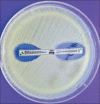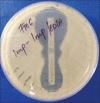Detection of Carbapenemase Production in Gram-negative Bacteria
- PMID: 25328329
- PMCID: PMC4196366
- DOI: 10.4103/0974-2727.141497
Detection of Carbapenemase Production in Gram-negative Bacteria
Abstract
The greatest threat to antimicrobial treatment of infections caused by Gram-negative bacteria is the production of carbapenemases. Metallo-beta-lactamases and plasmid-mediated serine carbepenemases like Klebsiella pneumonia carbapenemase are threatening the utility of almost all currently available beta-lactams including carbapenems. Detection of organisms producing carbapenemases can be difficult, because their presence does not always produce a resistant phenotype on conventional disc diffusion or automated susceptibility testing methods. These enzymes are often associated with laboratory reports of false susceptibility to carbapenems which can be potentially fatal. Moreover, most laboratories do not attempt to detect carbapenemases. This may be due to the lack of availability of guidelines and procedures or lack of knowledge and expertise. Because routine susceptibility tests may be unreliable, special tests are required to detect the resistance mechanisms involved. This document describes the standard methodology for detection of various types of carbapenemases, which can be put to use by laboratories working on antimicrobial resistance in Gram-negative bacteria.
Keywords: Carbapenemases; Gram-negative bacteria; Klebsiella pneumoniae carbapenemase; New Delhi metallo-beta-lactamase; metallo-beta-lactamases.
Conflict of interest statement
Figures
Similar articles
-
Prevalence of metallo-β-lactamase acquired genes among carbapenems susceptible and resistant Gram-negative clinical isolates using multiplex PCR, Khartoum hospitals, Khartoum Sudan.BMC Infect Dis. 2018 Dec 17;18(1):668. doi: 10.1186/s12879-018-3581-z. BMC Infect Dis. 2018. PMID: 30558551 Free PMC article.
-
Carbapenemase-producing Gram-negative bacteria: current epidemics, antimicrobial susceptibility and treatment options.Future Microbiol. 2015;10(3):407-25. doi: 10.2217/fmb.14.135. Future Microbiol. 2015. PMID: 25812463 Review.
-
[Comparison of phenotypic methods and polymerase chain reaction for the detection of carbapenemase production in clinical Klebsiella pneumoniae isolates].Mikrobiyol Bul. 2017 Jul;51(3):269-276. doi: 10.5578/mb.57333. Mikrobiyol Bul. 2017. PMID: 28929963 Turkish.
-
Global dissemination of extensively drug-resistant carbapenemase-producing Enterobacteriaceae: clinical perspectives on detection, treatment and infection control.J Intern Med. 2015 May;277(5):501-12. doi: 10.1111/joim.12342. Epub 2015 Jan 27. J Intern Med. 2015. PMID: 25556628 Review.
-
Detection of AmpC β Lactamases in Gram-negative Bacteria.J Lab Physicians. 2014 Jan;6(1):1-6. doi: 10.4103/0974-2727.129082. J Lab Physicians. 2014. PMID: 24696552 Free PMC article.
Cited by
-
Review of phenotypic assays for detection of extended-spectrum β-lactamases and carbapenemases: a microbiology laboratory bench guide.Afr Health Sci. 2020 Sep;20(3):1090-1108. doi: 10.4314/ahs.v20i3.11. Afr Health Sci. 2020. PMID: 33402954 Free PMC article. Review.
-
Antimicrobial resistance and metallo-beta-lactamase producing among commensal Escherichia coli isolates from healthy children of Khuzestan and Fars provinces; Iran.BMC Microbiol. 2020 Dec 1;20(1):366. doi: 10.1186/s12866-020-02051-8. BMC Microbiol. 2020. PMID: 33256594 Free PMC article.
-
Prevalence and characterization of beta-lactamase-producing Escherichia coli isolates from a tertiary care hospital in India.J Lab Physicians. 2019 Apr-Jun;11(2):123-127. doi: 10.4103/JLP.JLP_122_18. J Lab Physicians. 2019. PMID: 31160850 Free PMC article.
-
Genotypic diversity among multidrug resistant Pseudomonas aeruginosa and Acinetobacter species at Mulago Hospital in Kampala, Uganda.BMC Res Notes. 2017 Jul 14;10(1):284. doi: 10.1186/s13104-017-2612-y. BMC Res Notes. 2017. PMID: 28705201 Free PMC article.
-
Phenotypic and genotypic characterization of carbapenem resistance mechanisms in Klebsiella pneumoniae from blood culture specimens: A study from North India.J Lab Physicians. 2018 Apr-Jun;10(2):125-129. doi: 10.4103/JLP.JLP_155_16. J Lab Physicians. 2018. PMID: 29692574 Free PMC article.
References
-
- Tripathi P, Gajbhiye S. Prevalence of multidrug resistance, ESBL and MBL production in Acinetobacter spp. Int J Recent Trends Sci Technol. 2013;6:139–43.
-
- Mohamed N, Raafat D. Phenotypic and genotypic detection of metallo-beta-lactamases in imipenem-resistant Acinetobacter baumannii isolated from a Tertiary Hospital in Alexandria, Egypt. Res J Microbiol. 2011;6:750–60.
-
- Clinical and Laboratory Standards Institute. Wayne, PA, USA: CLSI; 2010. Performance Standards for Antimicrobial Susceptibility Testing, 20th Informational Supplement, January and June, 2010. M100-S 21.
-
- Hemalatha V, Sekar U, Kamat V. Detection of metallo betalactamase producing Pseudomonas aeruginosa in hospitalized patients. Indian J Med Res. 2005;122:148–52. - PubMed
LinkOut - more resources
Full Text Sources
Other Literature Sources





